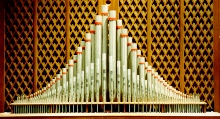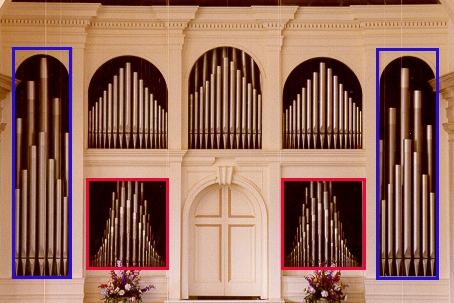

Pipe Ranks and Divisions
|
Although a rank will contain all the pipes necessary to play the full range of the keyboard associated with it, the individual pipes of a rank are not always placed in keyboard order, nor are they always placed in a straight line.
 When pipes are small - -
as in the case of a 2' or higher stop, the pipes might appear in a straight line if a
chromatic order
of pipes is followed. In the case of larger pipes, the pipes might be placed in a
staggered line in
order to prevent the entire rank from taking up too much space. In the diagram, each
circle
represents the diameter of a pipe in the first octave of an 8' Principal. As the
pitches
indicate, chromatic order is followed in the rank moving from front to back through a
staggered
line.
When pipes are small - -
as in the case of a 2' or higher stop, the pipes might appear in a straight line if a
chromatic order
of pipes is followed. In the case of larger pipes, the pipes might be placed in a
staggered line in
order to prevent the entire rank from taking up too much space. In the diagram, each
circle
represents the diameter of a pipe in the first octave of an 8' Principal. As the
pitches
indicate, chromatic order is followed in the rank moving from front to back through a
staggered
line.
The Photograph below shows a small manual division in which the pipes are arranged in
a similar
order. The rank at the front is a wooden 4' Gedeckt, with the pipes placed in a
staggered line
from left to right. Behind the Gedeckt are the other ranks of this division: a 2'
Gemshorn (barely
visible), a 2 2/3' Quint, and a 4' Principal. All ranks follow
the same pattern
of a staggered line, so that the pipes sounded by the lowest key are all in line from
front to back,
and so on across the width of the chest.

 When chromatic order is not
followed in the placement of a rank of pipes, several possibilities may be found.
One of the most
common plans is to place the first pipe in the center, and to arrange the rest of the
rank in
alternation to the left and right of the center pipe, as shown in this diagram. When
a rank of pipes
is arranged in this way, a pyramid shape results, with all the pipes on one side
forming a whole-
tone scale on C, and those on the other a whole-tone scale on C#. It is common to
refer to the
two sides of ranks so arranged as the "C side" and the "C# side."
When chromatic order is not
followed in the placement of a rank of pipes, several possibilities may be found.
One of the most
common plans is to place the first pipe in the center, and to arrange the rest of the
rank in
alternation to the left and right of the center pipe, as shown in this diagram. When
a rank of pipes
is arranged in this way, a pyramid shape results, with all the pipes on one side
forming a whole-
tone scale on C, and those on the other a whole-tone scale on C#. It is common to
refer to the
two sides of ranks so arranged as the "C side" and the "C# side."
The photograph below shows a rank of stopped metal pipes in the rear of the chest,
with several
higher-pitched ranks arranged in front of the first one.
22 The center pipe of each rank
is the one that sounds when the lowest C of the keyboard is played. In ascending
chromatic
order, the rest of the pipes follow the same pattern outward from the center, moving
from right to
left in alternation, shown in the diagram above.

In a typical organ with more than one keyboard, the stops and the ranks controlled by them are separated into different divisions. The most common and straightforward disposition of ranks of pipes is to group all of them that are played from a single keyboard on a separate chest. Ranks of pipes grouped in this way are made and voiced to be used together in various combinations, and they present a coherent sound when used in this way. A separate chest (more than one in the case of large instruments) with its pipes and played from a single manual or pedal keyboard is called a division. In some situations, a division may be referred to as an organ, a component of the larger instrument. Thus a reference to the Swell organ is equivalent to using the term Swell division. In common use, either term may be shortened to simply the Swell.
On a given instrument, separate divisions have tonal properties that contrast with one another in timbre, dynamics, pitch range or physical location of the pipes. In different countries and in different periods of the history of the organ, the ways in which these contrasts are made can be very specific, but within each type of organ there is some consistency. In an organ built in the US, the most common divisions and their characteristics are:
Although the common practice is to place all pipes of a division on a single chest, this is not always possible, particularly in the case of larger organs. Occasionally, a division will be split on two chests even though it may be small. Considerations of space combined with visual aesthetics may result in the splitting of a division onto separate chests that constitute a "C side" and C# side" that can be placed in different locations. For example, in the photograph below, the red rectangles identify the two sections of a split Great division, with the C side on the left and the C# side on the right. The blue rectangles outline the similarly divided pedal. 21

For more information on organ pipes. please make another selection from the
PIPES
menu.
For information about other parts of the organ, select "Return to Definition Menu."
For other choices, select "Return to Main Menu."
© 1998, James H. Cook